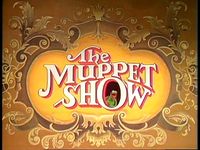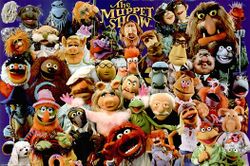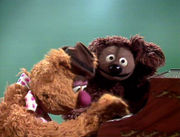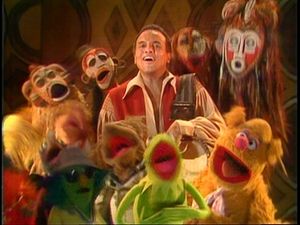The Muppet Show
| The Muppet Show | |
|---|---|
 Kermit the Frog as seen on the show's opening sequence. |
|
| Format | Live-action, Puppet show, Comedy, Variety |
| Created by | Jim Henson |
| Starring | Jim Henson Frank Oz Jerry Nelson Richard Hunt Dave Goelz Steve Whitmire Louise Gold Kathy Mullen Eren Ozker John Lovelady |
| Country of origin | |
| No. of seasons | 5 |
| No. of episodes | 120, including two pilot episodes that makes 122 (List of episodes) |
| Production | |
| Running time | 30 minutes per episode |
| Production company(s) | ITC Entertainment Henson Associates in association with CBS Television Stations |
| Broadcast | |
| Original channel | ITV (ATV Production) (UK) first-run syndication (US) |
| Original airing | |
The Muppet Show was a television programme produced by puppeteer Jim Henson and featuring a cast of Muppets. The series shows a vaudeville- or music hall-style song-and-dance variety show, as well as glimpses behind the scenes of such a show. Kermit the Frog stars as a showrunner who tries to keep control of the antics of the other Muppet characters (and his temper), as well as keep the guest stars happy. The show was known for outrageous physical slapstick, sometimes absurdist comedy, and humorous parodies. Each episode also featured a human guest star. As the programme became popular, many celebrities were eager to perform with the Muppets on television and in film: by the end of its run over one hundred guest stars had appeared.
Many of the puppeteers also worked on Sesame Street. Muppet performers over the course of the show include Henson, Frank Oz, Jerry Nelson, Richard Hunt, Dave Goelz, Steve Whitmire, Louise Gold, Kathy Mullen, Eren Ozker, and John Lovelady. Jerry Juhl and Jack Burns were two of the show writers.
Contents |
History
Since 1969, Sesame Street had given Jim Henson's Muppet creations exposure; however, Henson began to perceive that he was pigeonholed as a children's entertainer. He sought to create a program that could be enjoyed by young and old. Two specials were produced and aired that are considered pilots for The Muppet Show. Neither led to the sale of a prime-time network series. However, the prime-time access rule had just been enacted, which took the 7:30 to 8pm ET slot from the networks and turned it over to their affiliates. CBS suggested it would be interested in Henson's proposal as a syndicated series it could purchase for its owned-and-operated stations, to run one night a week in that time slot.
Lew Grade, head of the British commercial station ATV, offered a deal to Henson that would see his show produced at the ATV studios in Elstree, England. ATV, as part of the ITV network, would broadcast the show to other ITV stations in the United Kingdom, and its distribution arm, ITC Entertainment, would sell the show in the United States and around the world. Henson put aside his misgivings about syndication and accepted.
At first, signing guests was a challenge and producers had to call on their personal contacts. The breakthrough was the appearance of the ballet dancer Rudolf Nureyev. His appearance on such an unusual show generated such positive publicity that the series became one of the sought-after productions to appear in. The Muppet Show premiered in 1976 and finally, after five years and 120 episodes, it went off the air in 1981 because of Henson's desire to move on to other projects and the withdrawal of ATV's membership of the ITV network.
List of Muppet Show characters

- Kermit the Frog, director and host of the Muppet Show. He served as the main protagonist of the series, specials, and films. Performed by Jim Henson.
- Miss Piggy, a glamorous and self-centered diva pig in dual pursuit of stardom and Kermit. In the first season, her puppeteering duties were shared between Frank Oz and Richard Hunt. Starting with the second season, Oz took over the character full-time.
- Fozzie Bear, a dubiously talented but irrepressible stand-up comic bear, and Kermit's unofficial second-in-command. Performed by Frank Oz.
- Scooter, the gofer whose uncle owns the theatre. Performed by Richard Hunt.
- Gonzo, also known as The Great Gonzo or Gonzo the Great, stuntman, daredevil, performance artist and the Muppet Show's resident oddball of unknown species. Performed by Dave Goelz.
- The Swedish Chef, a cook with peculiar culinary habits who speaks a Scandinavian-sounding gibberish called "mock Swedish". Performed by Jim Henson with the hands of Frank Oz.
- Rowlf the Dog, the show's resident wisecracking piano player who also plays Dr Bob in the recurring 'Veterinarians Hospital' sketch. Performed by Jim Henson.
- Dr Bunsen Honeydew, head of Muppet Labs, a scientist and inventor. Performed by Dave Goelz.
- Beaker, Dr. Bunsen Honeydew's hapless guinea pig / assistant. Performed by Richard Hunt.
- Camilla, a chicken and Gonzo's true love. Usually performed by Jerry Nelson.
- Sam the Eagle, American super-patriot, resident grouch, and self-appointed censor of the Muppet Show. Performed by Frank Oz.
- Dr. Teeth, ultra-hip band leader, and keyboard player for Dr. Teeth and The Electric Mayhem. Performed by Jim Henson.
- Sgt. Floyd Pepper, bass guitarist and all around hip person of Dr. Teeth and The Electric Mayhem. Performed by Jerry Nelson.
- Janice, the Band's hippie-chick lead guitarist (and Floyd's main squeeze). Performed by Eren Ozker in the first season and Richard Hunt for the remainder of the run.
- Animal, the Band's savage, frenzied drummer. Performed by Frank Oz. Drumming performed by Ronnie Verrell.
- Zoot, the sleepy saxophone player in the Electric Mayhem and the Muppet Show's orchestra. Performed by Dave Goelz.
- Lips, trumpet player for the "Mayhem" added in the fifth season. Performed by Steve Whitmire.
- Lew Zealand, boomerang fish thrower and generally fish-obsessed performer. Performed by Jerry Nelson.
- Statler & Waldorf, two old men who occupy the box seat at every show and heckle the performances. Statler was performed by Richard Hunt, Waldorf by Jim Henson.
- Rizzo the Rat, a sarcastic inner-city rodent appearing in the fourth and fifth seasons. Performed by Steve Whitmire.
- Annie Sue, a young pig, Miss Piggy's innocent rival. Performed by Louise Gold.
- The Muppet Newsman, an energetic reporter who always had bad luck. Performed by Jim Henson.
- Foo-Foo, Miss Piggy's dog. Usually performed by Steve Whitmire or a real dog.
- Sweetums, a 7-foot-tall monster. Performed by Richard Hunt.
- Link Hogthrob, a hunky but dim-witted pig, star of "Pigs in Space", Captain of the USS Swinetrek. Also stars in "Bear On Patrol". Performed by Jim Henson.
- Dr. Julius Strangepork, the science officer in "Pigs in Space". Performed by Jerry Nelson.
- Beauregard, the dimwitted janitor and stagehand. Performed by Dave Goelz.
- Crazy Harry, a pyrotechnician and bomb expert who enjoys blowing things up far too much. Performed in the first season by John Lovelady, then taken over by Jerry Nelson.
- Robin, Kermit's small nephew. Performed by Jerry Nelson.
- Uncle Deadly, also called "the Phantom of the Muppet Show", a sinister character who lurks around the theatre and appears occasionally on the show. Performed by Jerry Nelson.
- Pops, the elderly doorman who greets the guest stars with a friendly "Who're you?". Performed by Jerry Nelson.
- Marvin Suggs, the sadistic, crazed and flamboyant Muppaphonist. Performed by Frank Oz.
- George the Janitor, the crotchety old janitor, seen primarily in the first season and performed by Frank Oz.
- Mildred Huxtetter, George's dancing partner, seen primarily in the first season. Usually performed by Frank Oz or Richard Hunt. Katherine French
- Hilda,is the seamstress/wardrobe mistress on The Muppet Show. For the most part, she only appears in the first season of the show; she makes rare appearances as a background character later. Hilda speaks with an Eastern European accent. Performed by Eren Ozker
Recurring skits

- At the Dance – The sketch was a regular during the first season but was used less frequently from the second season onward. Muppet characters circulated on a semi-formal dance floor offering rapid fire one-liner jokes and come-backs as the couples passed in front of the camera.
- Bear on Patrol – Fozzie is an unlucky police officer and Link Hogthrob is his incompetent superior who always get into the silliest situations with the criminals brought in. The voice of the announcer was performed by Jerry Nelson.
- Fozzie's Act – Fozzie Bear gets on stage and performs his infamously bad jokes. Statler and Waldorf heckle him, in a perpetual rivalry. The sketches became less frequent as Fozzie's off-stage presence became more prevalent. In one first season episode however, Fozzie turned the tables on his rivals with help from Bruce Forsyth, and they waved the white flag in surrender.
- Muppet Labs – Segments featuring the latest invention from Dr. Bunsen Honeydew, with his assistant, Beaker, getting the worst of its inevitable malfunction. The character of Beaker was introduced in the second season; during the first season Bunsen hosted Muppet Labs by himself, but the writers soon realized that another character was necessary to show Bunsen's failings.
- Muppet News Flash – A news announcer, a variation of the Guy Smiley puppet, gives a newsbrief only to have some disaster befall him (typically the same disaster he was just describing), or another strange scenario: such as the time that he ran on, stated "There is no news tonight.", and ran off. In the first season, the Muppet News Man read out news items that occasionally featured the guest star for that week playing a character that was somehow involved in the item. Muppet News Flashes often used absurdist humor; in one sketch, the announcer stated that the Atlantic Ocean had been kidnapped. Another example is this statement: Reports are coming in from all over the world that Television News Reporters are blowing up. These unlikely rumors are... KA-BOOM! A third example, a cross-over with the Swedish Chef, has the Swedish Chef open and cause a wine bottle "explosion" (if a bottle is shaken too much before opening it for the first time, fizz will shoot up and out of the bottle) and flies through the air, classified as a UFO by the news reporter. As the scene goes, he was reported directly above the Muppet News Room and he landed on and crushed the news reporter.
- Pigs in Space – Parody of science fiction shows like Star Trek, but also old '30s sci-fi serials. The spacecraft is called USS Swinetrek and the title voice-over is a parody of main Star Trek competitor Lost in Space. It features Captain Link Hogthrob, Miss Piggy as first mate, and Dr. Julius Strangepork (the name a takeoff on "Dr. Strangelove"). Usually, the sketches would involve the long-suffering Piggy putting up with the wacko Strangepork and the brain dead Link treating her as an inferior because she is a woman. The early sketches also usually featured odd introductions for all the characters, such as calling Link the flappable captain, Miss Piggy the flirtatious first mate, and referring to Dr. Strangepork as 'describable.' Strangepork usually got the most unusual description out of the three during these introductions, as he was the oddest member of the group. This portion of the introduction was dropped during the third season, and the announcer would simply claim it was 'time for...Piiiiiigs...iiiin...spaaaaaaace!'
- Swedish Chef – Cooking show parody. It consists of the Swedish Chef, who speaks mock Swedish, semi-comprehensible gibberish which parodies the characteristic vowel sounds and intonation of Swedish. He attempts to cook a dish with great enthusiasm, until the punch line hits. A hallmark of these sketches was the improvisation between Jim Henson, who performed the Chef's head and voice, and Frank Oz, who was his hands. One would often make something up on the spot, making the other puppeteer comply with the action. Famous gags include "chickie in du baskie" ("two points!"), meatballs that bounce, chocolate "moose", attempting to cook Kermit's nephew and perhaps most famously, repeatedly adding pepper to a recipe.
- Vend-a-face – A vending machine that offers unique face-changing services – usually agonizing contortions of the Muppets who feed the machine. It was originally intended to be a one-time sketch. However, because the Vend-a-face puppet was so costly to make, it was used multiple times to justify its creation. One sketch that did not deal with mock face lifts was when it claimed to dispense psychological advice, and repeatedly asks Fozzie Bear to deposit another coin. After Fozzie does this several times, Vend-a-Face tells him, "Your problem is: you are too generous".
- Veterinarian's Hospital – Parody of the soap opera General Hospital and other medical dramas, consisting of Dr. Bob (Rowlf) cracking corny jokes in the operating room with Nurses Piggy and Janice, much to the confusion of the hapless patient. Each installment ends with Dr. Bob and his nurses looking around in puzzlement as a disembodied narrator tells viewers to tune in next time to the "continuing stooory". On a number of occasions, the "Veterinarian's Hospital" sketch would crossover with the cast or set of another, such as "At the Dance" or "Pigs in Space." In the first season the narrator was usually voiced by John Lovelady, but Jerry Nelson performed the role in both the Harvey Korman and Rita Moreno episodes, before taking over the role permanently from the Phyllis Diller episode. In the introduction, Dr. Bob went from "a former orthopedic surgeon" to "a quack" who's "gone to the dogs."
- Wayne and Wanda – Usually introduced by Sam the Eagle as part of his idea of "good, wholesome entertainment", Wayne and Wanda – a slapstick tribute to Nelson Eddy and Jeanette MacDonald – sing songs that inevitably end in disaster. It is considered an accomplishment for them to get to the chorus. After a recurring run in the first season, they disappeared after Wanda's puppeteer, Eren Ozker, quit the show. Wayne still appeared occasionally as a background character or as the hero in a series of Melodrama sketches co-starring Miss Piggy and Uncle Deadly, but soon vanished as well. It was eventually revealed that Kermit had fired them, but forgot why he did and decided to rehire them. Unfortunately, seconds after they started to sing, Kermit remembered why he fired them (because they were terrible) and instantly fired them again and forced them off the stage. Wayne and Wanda would reappear in The Muppets Take Manhattan as guests at the wedding of Piggy and Kermit, and Wanda was seen participating in a choir.
Guest stars

No guest star ever appeared twice on The Muppet Show, although John Denver appeared both on the show and in two specials (John Denver & the Muppets: A Christmas Together and John Denver & the Muppets: Rocky Mountain Holiday). Additionally, several guest stars from the show had cameos in one of the first three Muppet theatrical films.
Many episodes featured people most UK viewers had barely heard of at the time, such as Linda Ronstadt; some featured veteran performers like Ethel Merman and Rita Moreno; some featured well-known pop singers, including Elton John and Leo Sayer. Sayer's show used his hit "The Show Must Go On": he changed the lyrics in the second verse slightly, from "I wish I could tear down the walls of this theatre" to "I wish I could tear down the walls of this Muppet theatre". The last episode, in 1981, featured then-James Bond 007 actor Roger Moore.
When the show first started, the producers would call upon friends in the entertainment business. However, about half-way through the second season when Rudolph Nureyev appeared, his appearance gave the show so much positive publicity, that other celebrities came to the producers instead of the other way around. One unusual guest star was one of the series writers, Chris Langham, who took the place for Richard Pryor when the star was unable to attend taping.
- List of The Muppet Show episodes
The Muppet Theater
The Muppet Theater is the setting for The Muppet Show -- a grand old vaudeville house that has seen better days. In episode 106, Kermit identifies the name of the theater as The Benny Vandergast Memorial Theater, although by the time of It's a Very Merry Muppet Christmas Movie, it is simply called "The Muppet Theater." It is then that the theater becomes registered as a historical landmark.
According to The Phantom of the Muppet Theater, the theater was built by a stage actor named John Stone in 1802. At some point a production of Hamlet ran in the theater, with Stone playing the title role. An alternate exterior is also shown in the book.
Locations seen in the Muppet Theater include backstage right, the dressing rooms, the attic, the canteen, the prop room, the stage, the house, the stage door lobby, and the back alley.
Scooter's uncle J.P. Grosse owns the theater, and rents it to the Muppets, as Scooter is only too happy to remind Kermit. In a deleted scene from It's a Very Merry Muppet Christmas Movie, Kermit reveals that J.P. has died and left the theater to the Muppets in his will. This would have taken place sometime after 1996, as J.P. can be seen (and referred to as such by the head of the KMUP network) in episode 107 of Muppets Tonight, the 1990s reworking of The Muppet Show.
Awards
The Muppet Show was nominated for a total of 21 Primetime Emmy Awards, winning 4, including the 1978 award for Outstanding Comedy-Variety or Music Series.[1] The program was also nominated for 11 BAFTA Awards during its run, winning 2,[2] and was presented with a Peabody Award in 1978.[3]
Syndication
Reruns of The Muppet Show aired in syndication for many years and eventually turned up on TNT from the channel's sign-on in 1988 to 1992. From 1994 to 1997, reruns aired on Nickelodeon. In 1999, the reruns moved to Odyssey Network (which was co-owned by Henson's company), featuring new introductions by Brian Henson, until Odyssey shut down Henson's half of the channel in 2001; the show has not been seen on American television since.
Outside the US, The Muppet Show and MuppeTelevison segments and Muppets Tonight were all put into an umbrella syndication package called The Jim Henson Hour. Disney Channel UK picked up the original series from 2005-2007.
DVD releases
Time-Life began marketing 'best of' volumes of The Muppet Show for mail-order in 2001, with six initial volumes with 3 episodes on each DVD at the cost of $19.99 USD each. Unique to each episode was an introduction by Jim Henson's son, Brian. Nine more volumes were added for 2002, the Muppet's 25th anniversary. The collection was available for retail in 2002 via Columbia Pictures Home Video by which time Time-Life had released its tenth volume.[4] (There were five additional Time-Life 'best of' volumes released only on VHS.)
Walt Disney Studios Home Entertainment, a division of The Walt Disney Company, released the first season on DVD in Region 1 on August 9, 2005. The rights to the episodes and characters used in The Muppet Show, and subsequent film outings, were bought in February 2004 by The Walt Disney Company.
Several songs were cut from the Season 1 DVD release due to music licensing issues. There have also been some cuts in the intro sequence, and backstage scenes leading up to these songs. However, episodes that used Disney music remained unaltered (for example, episode 14 of Season 1 used "Never Smile at a Crocodile" from Peter Pan).
-
- "Stormy Weather" (Joel Grey episode) Sung by Wayne and Wanda;
- "Gone with the Wind" (Jim Nabors episode) Sung by Jim Nabors;
- "The Danceros" (Jim Nabors episode) Sung by The Danceros;
- "All Of Me" (Paul Williams episode) Sung by Two Monsters;
- "Old Fashioned Way" (Charles Aznavour episode) Sung by Charles Aznavour with Mildred;
- "You’ve Got A Friend" (Vincent Price episode) Sung by Vincent Price, Uncle Deadly and a chorus of Muppet Monsters
| DVD Name | Ep # | Release Date | Content |
|---|---|---|---|
| Season One | 24 | August 9 2005 |
|
| Season Two | 24 | August 7 2007 |
|
| Season Three | 24 | May 20 2008[5] |
|
| Season Four | 24 | TBA 2010 |
Spin-offs
The Muppet Show characters went on to star in The Muppet Movie, which was the first film to feature puppets interacting with humans in real-world locations, and later films such as The Great Muppet Caper, The Muppets Take Manhattan, The Muppet Christmas Carol, Muppet Treasure Island, Muppets from Space, and The Muppets' Wizard of Oz.
The Jim Henson Hour featured many of the same characters, plus new and boldly different content. The Muppets appeared as toddlers in the long-running animated series Muppet Babies. The Muppet Show format was later revived as Muppets Tonight in 1996. The first 10 episodes aired on ABC while the rest aired on The Disney Channel. Today, all three incarnations are syndicated together as a single package.
In 2005, the Muppets launched an award-winning webseries titled Statler and Waldorf: From the Balcony. The biweekly webshow created new episodes for 15 months on movies.com and starred Statler and Waldorf along with many other popular Muppet characters from their theater box from The Muppet Show. Each episode featured the duo as they discuss upcoming films, watch movie trailers and share the week's "balconism".
There is talk of a new revival of the format, with FOX being the initial serious contender. Disney considered using the America's Next Muppet mini-series to test the viability of a full-fledged series.
The hit Broadway and West End Musical Avenue Q is loosely based on The Muppets as well as Sesame Street but is required to provide disclaimers stating that it has nothing to do with the characters, particularly due to the musical's adult theme.[6][7]
The Muppets were brought back in 2008 for a short on the Disney Channel called Studio DC: Almost Live.
For the muppets.com channel on Disney Xtreme Digital, over 100 new, web-exclusive sketches have been produced as of January 2009.[8]
The Muppet Show Comic Book began publication in 2009 written and drawn by Roger Langridge and published by Boom! Studios.
In France, in 2006, the first French private TV network TF1 produced with Walt Disney a new version with originals Muppets and French guest stars. Low ratings killed the program after few months.
See also
- Adult puppeteering
- Le Bébête Show
- List of television programs
- "Mah Nà Mah Nà"
- Meet The Feebles
- Muppet Babies
- Palisades Toys
- Sam Pottle
- The Muppet Show: Music, Mayhem, and More (audio CD)
References
External links
- The Muppet Show on Muppet Wiki, an external wiki
- The Muppet Show at the Internet Movie Database
- The Muppet Show at TV.com
- "Of Muppets and Men," a 1981 documentary on the making of the show
- The Jim Henson Works at the University of Maryland 70+ digital videos available to students, scholars and visitors at the University of Maryland (College Park, MD)
- A chart of muppet characters arranged by performer
|
||||||||
|
||||||||||||||||||||